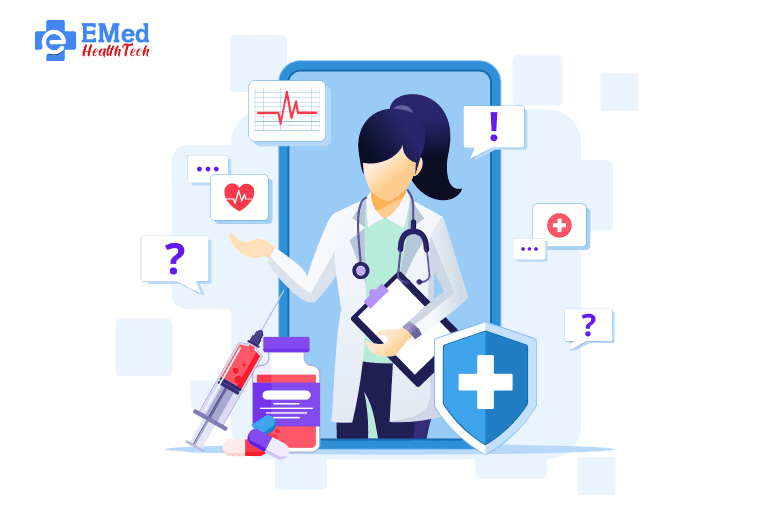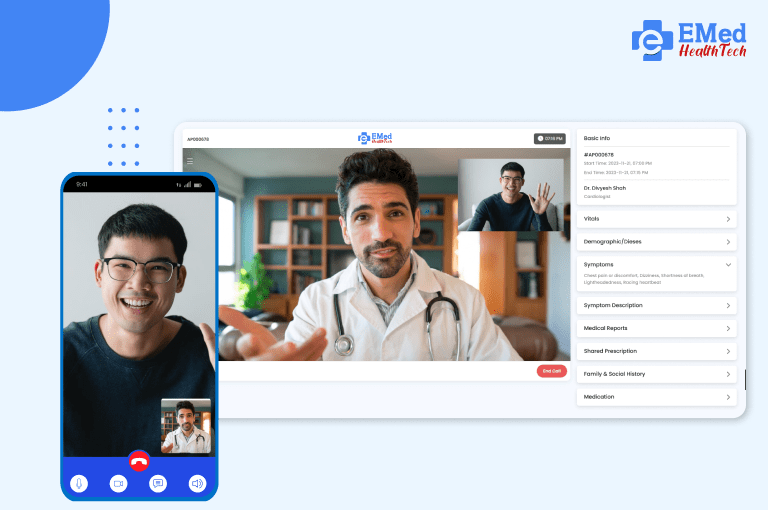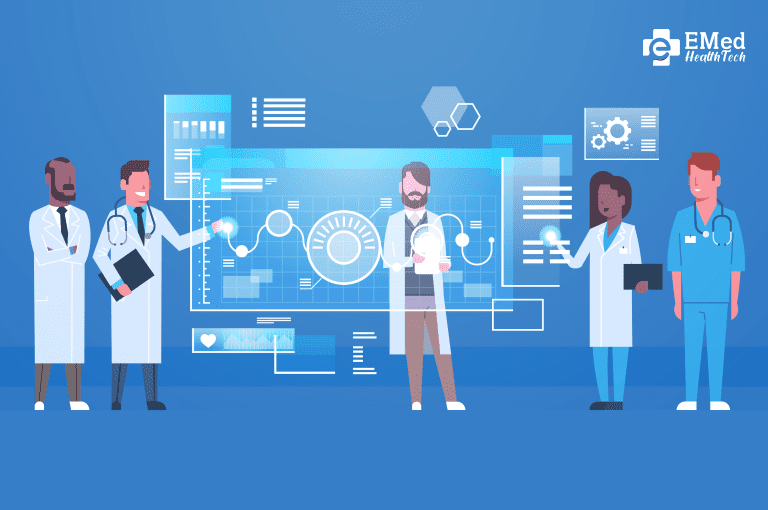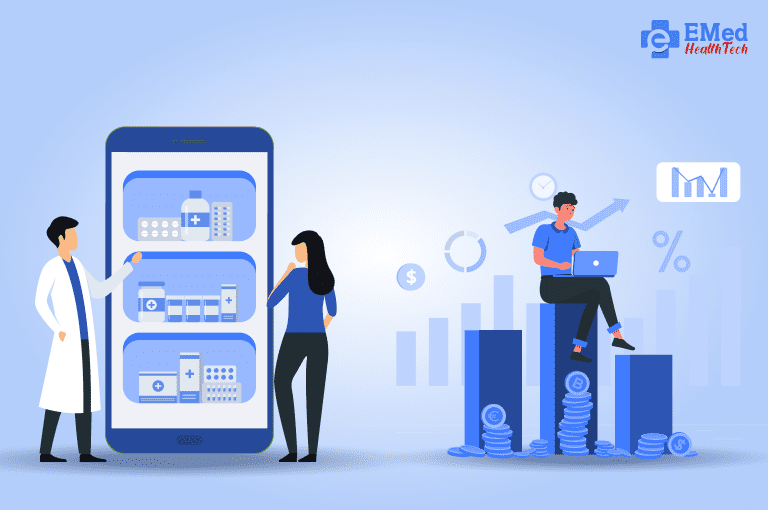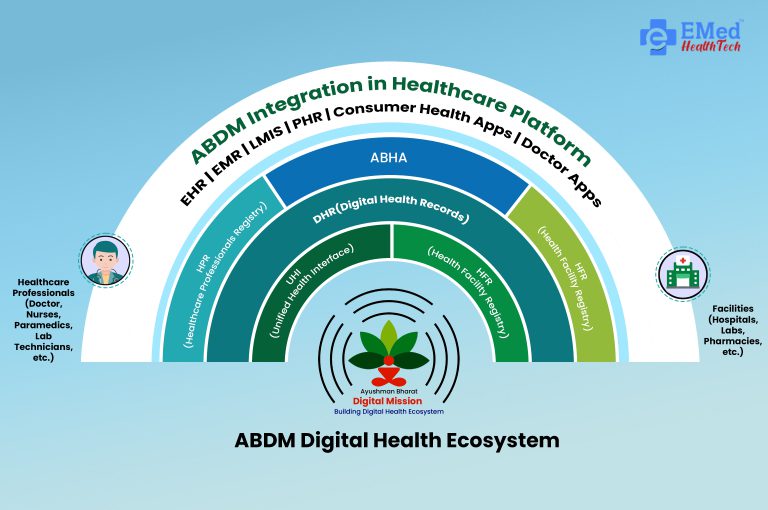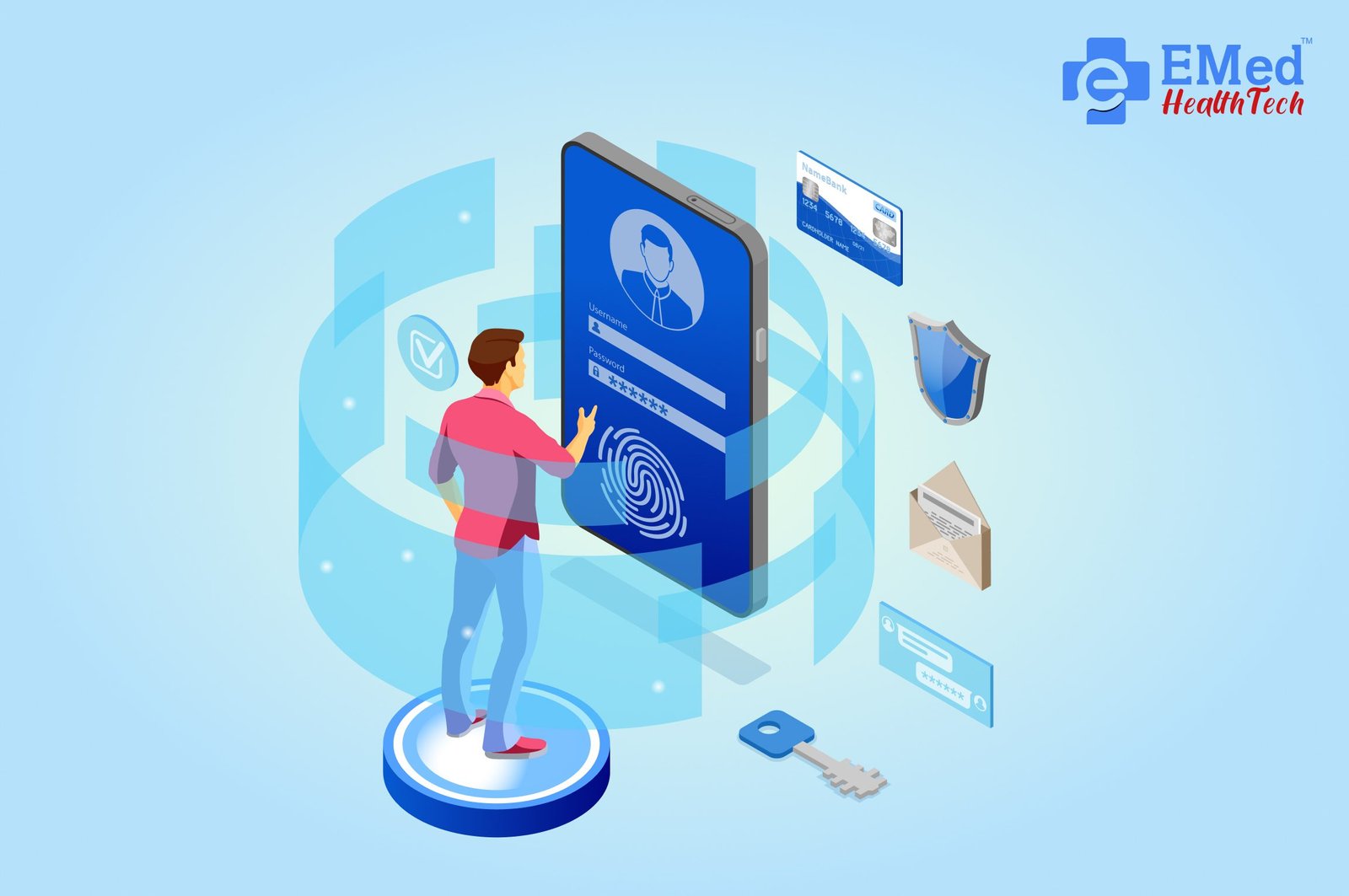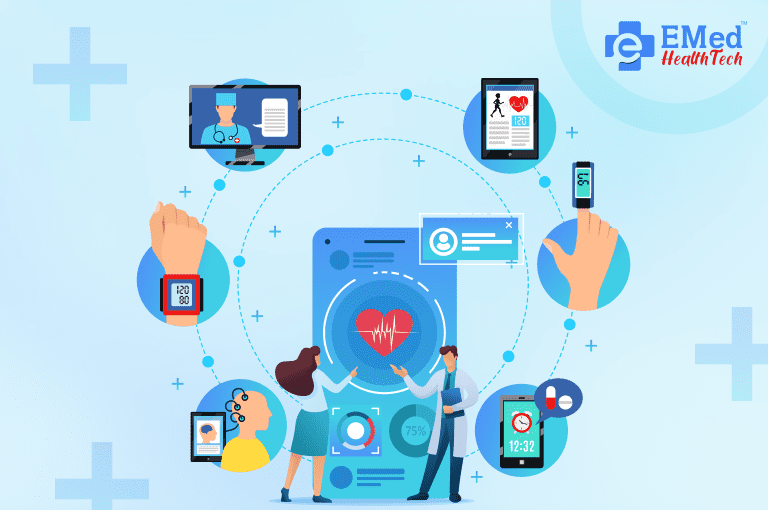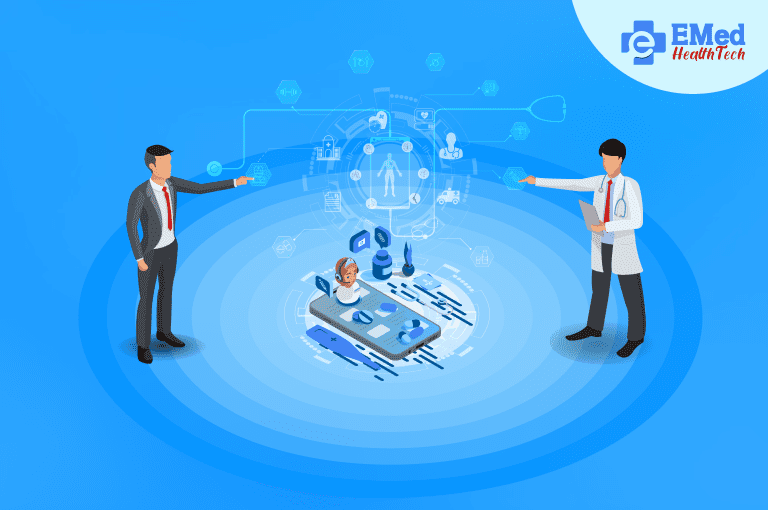The growth of application development is causing enormous changes in the healthcare services industry. This explains why the medical industry is currently witnessing parabolic growth in the creation of healthcare applications. Here is an extensive guide that covers all the areas because we know how important it is to maintain a competitive edge in this fast-paced sector. We discuss the many types of healthcare applications, their features and advantages, how to create one, typical issues, and much more.
The process of developing a smartphone app that enables users to track their health in real-time is known as “healthcare app development.” Additionally, consumers may obtain all the medical information they require with a single flick of their finger thanks to healthcare apps for mobile devices.
Apart from accomplishing several assignments for medical service providers and doctor-on-demand services. Our group has collaborated with a producer of medical equipment to create mobile applications. Not only did we participate in consultations with the public sector, but we also drafted national standards for tele-monitoring systems. Additionally, we helped our business successfully provide new teleconsultation products to clients. In addition, we have executed investor expectations, supported millions of dollars worth of investment rounds, and assisted early-stage firms.
Specific Information
Applications for telemonitoring and teleconsultation
An effective and secure way for patients and healthcare professionals to communicate via mobile apps or internet platforms. This type of digital solution can help with video consultation scheduling, payment, and execution. Additionally, the feature that allows physicians to upload test results allows them to monitor Custom Healthcare App Development. Additionally, we can design modules that make phone conversations and text messaging easier.
Those who regularly monitor
Keeping track of incidents that might affect our health and safety is the purpose of these apps. Based on the information they gather, doctors make diagnoses and suggest treatments. An intelligent habit tracker can assist the user in leading a healthier lifestyle by minimizing exposure. To potentially dangerous substances and encouraging the adoption of positive habits into everyday life. The comprehensive solution attends to both the person’s physical and mental health.
Coordination of activities and planning
Work planning in medical institutions has the power to significantly improve cost-effectiveness. It also includes service quality, safety, and patient and staff happiness. Our algorithms have assisted us in scheduling over two million tasks alone in the past year. In comparison to pre-digital times, nursing homes were able to increase their efficiency by 20% with their assistance.
A physician on call at all times
Platforms that provide doctor-on-demand services must ensure that patients may swiftly and easily schedule medical home visits. The quantity and range of services provided by these facilities have increased, but appointment cancellations have decreased. Such applications are the most practical approach to providing medical care since they provide a contemporary, transparent accounting model that benefits patients, physicians, and insurance companies.
The mechanisms that enable sales
When the healthcare industry digitizes the customer journey, everyone benefits from increased opportunities to identify new customers, simpler purchasing, more effective salespeople, and reduced expenses associated with sales operations. It becomes extremely creative and successful when combined with software designed to promote healthcare goods and services.
Routine conceptualization and development
Every time we get the chance to develop a new digital product, we eagerly anticipate the opportunity to take on new challenges. We aim to offer specialized systems that will correspond with the distinct requirements of your business. We create MVP concepts, develop and test new solutions, refine them to meet client specifications, and provide post-release support. You’ll get a full range of services catered to your needs when you work with us.
When you collaborate, you’ll gain multiple benefits:
Knowledgeable consultants in the area of health technology
We have been helping sponsored health tech businesses, public health agencies, and other health organizations with Healthcare App Development and healthcare integration for many years.
Flexible methodology
We will collaborate with you to identify the goals of your company using contemporary agile approaches, and we’ll then craft a solution that satisfies every requirement of your clientele.
Adherence to the regulations
Not only are our health technology teams adept at operating under standard healthcare governance frameworks and regulatory requirements, but they also hold ISO accreditation and assurance.
Recent advancements in technology
Our Healthcare App Development Company team wants to produce a scalable architecture for a health technology solution that beats the competition by using cutting-edge frameworks and technologies.
An enterprise that creates healthcare-related apps using any kind of business model and client engagement form is known as a medical Telehealth Mobile Apps development firm. Examining an IT supplier’s portfolio to determine which examples meet the needs of your project is one method to choose one. Another is perusing feedback from previous customers on reliable sources. To make sure everything works properly, it’s a good idea to hire healthcare EHR & EMR App developers even if you have engineers on staff who can construct an HIT app.
Some of the most well-known names in healthcare app development may include features like push alerts, clinical photo capture, simple sign-in, medication reminders, and much more.
Simple method to book an appointment of doctor by online Mobile Health Apps:
OPD Management System and Online Appointment (e-Health Track)
Patients will save a great deal of time and have better relationships with hospital administration because of the online outpatient department appointment system. Process simplification might be possible for hospital administrators with significantly better operational control. Customers can look through the various service providers and businesses’ available appointment times and select the time that works best for them.
Integrated with healthcare systems
With a range of telehealth apps, doctors may now have in-depth conversations with patients from a distance. By increasing the dependability of healthcare operations and systems, mobile app development for the industry reduces repetitious duties. Numerous trips to the doctor are no longer necessary thanks to online access to prescription history and medical records.
Remote Patient Monitoring
Healthcare providers can continuously monitor and assess a patient’s health status outside of a traditional clinical setting with remote patient monitoring, which uses technology like wearables, sensors, and mobile applications to collect and transmit health data from patients to healthcare providers.
ABDM Integration
The essential elements of ABDM can be linked to several digital health solutions via application programming interfaces (APIs). Since they have API connections with both HFR and HPR, in this scenario, the telemedicine service provider would have access to all of these modules. This ABDM system consisted of three parts: Health Identification, Healthcare Facilities Registry, and Healthcare Professionals Registry.
EMR/EHR Software development
Healthcare apps frequently integrate with Electronic Health information (EHRs) so that physicians may examine real-time patient diagnoses, treatments, and medical information. Better decisions and patient care result from this. Despite having the same sound, they have different meanings. “Electronic medical records” (EMR) and “electronic health records” (EHR) are terms used to describe the digital storage of medical records. Compared to EMR, the former goes farther and covers more ground.
App for ambulance booking: Emergency Ambulance Booking Advanced System based on GPS live location to track instantly
With GPS real-time position tracking, the first emergency ambulance booking system in India is already up and running. Our app, which works with both iOS and Android devices, makes it simple and quick to call for an ambulance to arrive at your location. Get immediate access to medical care that could save your life. It makes it possible to give primary care while on the go.
Connected Health Ecosystem
Programs for connected health are frequently linked to efforts to enhance chronic care. These programs cover telehealth, managing illness and lifestyle, remote care (including home care), and utilizing modern technology, like linked gadgets via cellular networks. Healthcare providers can securely access patient data by participating in a networked ecosystem, which enables them to use the data to provide high-quality care for the duration of the patient’s journey.
Data Security in Telehealth
The necessity to protect patient data is increasing as more and more healthcare services are being provided online. Robust authentication procedures and encryption systems are necessary to stop illegal access and data breaches.
Blockchain
Mobile apps can be used to send patient medical records to a distributed ledger system. Blockchain-based digital contracts allow sensors and smart devices to interact with one another. Most healthcare facilities use electronic health records regularly.
Healthcare Ecosystem
These days, when someone refers to the healthcare ecosystem, they typically mean the entire medical and healthcare industry. This community includes all those involved in the care or hospital stay of the patient or visitor, including the physician, the patient, and any supporting roles.
Patient Empowerment Through Technology
As a technique, it gives people the ability to take charge of their lives and make changes in the areas that matter most to them. Finding and honing your innate ability to be your boss is one of the most crucial aspects of becoming powerful. A key component of patient empowerment is assisting patients in realizing and enhancing their innate ability to take charge of their own lives.
AI/ML Based Healthcare Systems
The term “artificial intelligence” (AI) refers to programs and algorithms that can process, visualize, and comprehend vast volumes. It is of intricate medical and health care data in a way. That is on par with or superior to human intellect through experience. Machine learning might potentially identify people who have a high risk of acquiring diabetes. And then provide them with individualized advice on diet and exercise to help ward off the condition. AI can also monitor a patient’s vitals from a distance. And notify a doctor of any changes before something bad occurs.
Healthcare Analytics
Biostatistics is the discipline that ought to guide the analysis of health data. Health analytics is the process of assessing pertinent healthcare data to enhance diagnoses, treatments, and outcomes. Prominent technology firms in the nation are working with healthcare institutions to discover novel applications. For the massive quantities of health care data generated and gathered daily, for the benefit of individuals and communities.
IoT
The Internet of Things (IoT) is a network that facilitates the sharing of data and enables the connecting of several types of electronic devices. For example, a health app may keep an eye on the temperature of your refrigerator, order more milk when it runs low, and then recommend how much to buy based on how many people in your home will be using it.
The material covered here may be useful to you if you’re creating a healthcare app from scratch or if you already have one and are attempting to make it stand out from the competition.
There are many opportunities for innovation in the healthcare sector given the industry’s rapid expansion. By using these elements in your healthcare applications, you may differentiate yourself from the competition.
How much does the process of creating a healthcare app cost?
By the end of 2023, the global market for mobile health is projected to generate $119.5 billion in sales; by 2028, it may reach $400 billion. The digital health sector is anticipated to grow at a CAGR of 27.0% between 2023 and 2028. However, this growth is being driven by the widespread adoption of smart devices and digital health services as a simple and practical means of receiving medical care for people all over the world.
Younger generations’ increasing emphasis on personal fitness and health, along with the rising use of smart apps. These are predicted to fuel the market’s anticipated growth shortly.
The market is expected to grow even faster in the next years due to the increased demand for mobile health apps along with the growing need for remote patient monitoring and digital health services.
Compliance and Regulation:
A significant amount of the money allocated for developing the mobile healthcare app goes into fulfilling all relevant legal and regulatory obligations. Patient information is secure when this compliance is strictly adhered to.
Patients will be protected from any unethical or unlawful medical operations by adhering to these guidelines. When assessing the development costs of a healthcare application, it is important to take into account the essential elements and related security standards.
Data security and privacy:
Digital healthcare apps must guarantee the protection, encryption, and non-sharing of user data. They are with third parties without the express consent of the user. It was given the rising frequency of data breaches and security risks. Applications must abide by several laws and rules. That is to ensure that privacy and data protection standards are met. However, a couple of such include the Health Insurance Portability and Accountability Act (HIPAA) and the General Data Protection Regulation (GDPR).
Guidelines for medical equipment:
Applications used in healthcare that include prescription drugs are subject to rules established by regulatory agencies such as the FDA. The Food and Drug Administration (FDA) also provides rules to makers of mobile healthcare applications that fall under the category of medical devices.
Ethical considerations:
Developers of healthcare apps should adhere to certain ethical guidelines and recommendations issued by the World Health Organization (WHO) and the International Medical Informatics Association (IMIA). By using these strategies, harmful habits and inaccurate or misleading information are prevented from spreading.
Advertising and marketing:
Healthcare applications must abide by marketing and advertising regulations to be deemed compliant. App developers must ensure that their products don’t endorse therapies or treatments that lack scientific validation.
Final Words
Many businesses have established themselves as industry leaders in the creation of healthcare applications. Every service that these companies provide is excellent. Moreover, it is noteworthy that the list that was earlier exhibited was produced after considerable collaboration. It was between our group and many healthcare mobile app users. These clients had the opportunity to offer their opinions on the On-Demand Doctor App Development services. Provided by the provider and were involved in a variety of healthcare initiatives. As leaders in blockchain technology, these providers of healthcare application development services have established themselves globally.
If you send us an email, we can assess your medical mobile app development company. We can include your organization in reports such as this one. If it also provides services for Online Pharmacy App Development. After evaluating your organization, our experts will determine whether it meets the requirements for registration. These advertisements will help you because they will increase your visibility to prospective customers.
